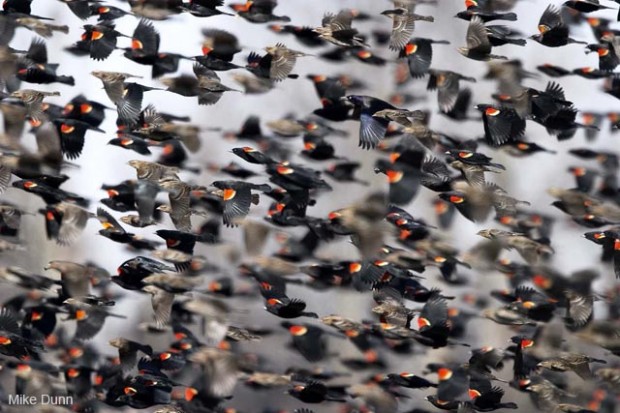
The troubling demise of red-winged blackbirds continues in America’s South. Five hundred of the dead birds turned up along a roadside in Pointe Coupee Parish, Louisiana, near Baton Rouge�only a few days after more than a thousand of the birds seemed to fall from the sky in Beebe, Arkansas.
It’s worth pointing out that while Point Coupee and Beebe are both in the South, they aren’t exactly across the road from one another; they’re about five hundred miles apart as the blackbird flies. (I have relatives living quite close to each location�a brother in Baton Rouge, LA and a sister-in-law in Evening Shade, AR. I haven’t asked them for comment, dead creatures being not uncommon in those parts.) While similar weather conditions in the two places might have contributed, the incidents are likely unrelated.
The redwing blackbird is a characteristic roadside bird of the Southern and Midwestern United States. It’s a bird many of us associate with happy memories�anyway, I do: not long after I met the woman I would marry, I took her to visit my family; on the way down, she saw a handsome bird by the road. “What’s that black bird with red wings?” she asked. “A redwing blackbird,” I replied. In warm months it’s often seen in this habit, a solitary bird perched on barbwire fences and utility lines, while in the cold months the birds gather in great flocks that balloon over the stubbled fields in prodigious displays of collective intelligence.
Or perhaps it’s collective unintelligence�as conservation officials have pointed out, it’s likely that this very flocking behavior, and not UFOs or secret weapons testing, have caused the massive kills. Extensively modeled and even emulated in artificial intelligence systems controlling robots and autonomous flying drones, flocking behavior allows groups of autonomous individuals to knit together in close, high-speed harmony. But it can be dangerous; lurching aloft in response to startled flockmates, birds risk hurtling into walls, tree limbs, even the ground. Add darkness and bad weather, and it can be very dangerous to be a member of a redwing flock. [reporting via Christian Science Monitor]
 Gearfuse Technology, Science, Culture & More
Gearfuse Technology, Science, Culture & More



I don’t follow the global warming theory too much, however, it seemed seasonably warm around those days. I think it could have been the heat or something they ate or both.